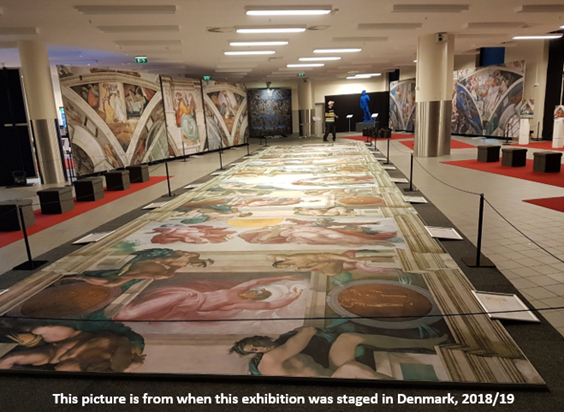The Stetson Group in association with Auckland Live presents
Michelangelo – A Different View
Under license from the Vatican Museums, this exhibition offers the most complete and authentic reproduction of Michelangelo’s beautiful ceiling frescoes of the Sistine Chapel to be shown outside the Vatican.
Aotea Centre, Auckland | 3 - 30 January 2022
Early Bird tickets on sale this Friday via Ticketmaster
Early Bird $39* | After Christmas $45*
Children under 12 Free (must be accompanied by an adult)
*Plus service fee
Until recently, over four million people visited the Sistine Chapel in Rome every year to admire the beautiful ceiling frescoes by Michelangelo in the early 1500s.
With sightseeing holidays to Europe unlikely for New Zealanders anytime soon, the promoters of Michelangelo — A Different View today announce they’re bringing Rome to Auckland this January.
Under license from the Vatican Museums and brought to New Zealand by The Stetson Group, the same promoter who presented the hugely successful The Art of Banksy Exhibition three years ago, this significant exhibition will be hosted at the Aotea Centre, Auckland, from 3-30 January 2022.
Early Bird tickets go on sale to the public this Friday via Ticketmaster. Visitor numbers will be limited so don’t delay!
Michelangelo — A Different View presents a very different picture of Michelangelo’s works: the exhibition shows photo-mechanically reproduced copies almost in original size and in a way that invites visitors to look at them up close and in their own time.
Michelangelo — A Different View is a transformative experience that allows attendees to look down on ‘The Genesis’ that is enshrined on the ceiling of the Sistine Chapel rather than up…. hence the exhibition’s name A Different View. This offers a much closer perspective of what its Florentine creator did. The rest of the frescoes are in frames and can be viewed from within 2 metres.
With no time constraints, visitors can allow these masterpieces to truly soak in.
Some 50 pieces, including an almost original size, 4.6m x 20m reproduction of ‘The Genesis’ (which includes The Creation of Man) and a 3.8m x 3.8m version of ‘The Last Judgment’ are just 1-2 metres away from the viewer, while audio guides, accessible via personal devices (please bring your own phone, head set/earbuds), mean visitors can experience the Florentine master’s interpretation of The Bible’s creation story in a way they never imagined.
As an addition to – and to complete – Michelangelo — A Different View, reproductions of 14 of these impressive frescoes await visitors in the entrance. Scenes from the lives of Jesus and Moses, painted by Sandro Botticelli, Pietro Perugino, Domenico Ghirlandaio and Cosimo Rosselli, provide additional historical background and allow for a deeper insight into this epoch.
Promoters Stewart and Tricia Macpherson of the Stetson Group say they are honoured to be able to present such a significant exhibition in New Zealand.
“Most people will only have dreamed of seeing these paintings in the Sistine Chapel,” says Stewart. “This is the closest we’ll get to the real thing anytime soon. And the fact they’ll be just metres away, is extraordinary.”
For media inquiries, contact Sandra Roberts | sandra@skip.co.nz | 021 525104
Print quality photos and video available for download at skip.co.nz
michelangeloadifferentview.com
*Plus service fee



